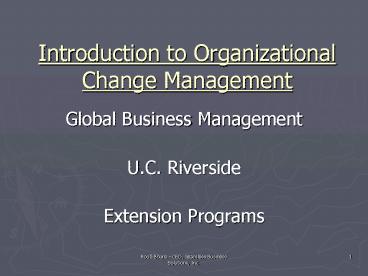Introduction to Organizational Change Management - PowerPoint PPT Presentation
1 / 23
Title:
Introduction to Organizational Change Management
Description:
Obsolete systems. Advancement. Competition ... behaviors, norms, values, and expectations acquired over a long period of time. ... – PowerPoint PPT presentation
Number of Views:1093
Avg rating:3.0/5.0
Title: Introduction to Organizational Change Management
1
Introduction to Organizational Change Management
- Global Business Management
- U.C. Riverside
- Extension Programs
2
Objectives
- Develop a better understanding of organizational
changes - Learn basic rules of OCM (Organizational Change
Management) - Develop a plan to apply OCM rules in the work
environment
3
What is an Organizational Change?
- An event that creates a significant (positive or
negative) disruption of established or expected
patterns at work
4
Why is change necessary?
- Obsolete systems
- Advancement
- Competition
- Cost of the status quo is greater than the cost
of change
5
Characteristics of a turbulent work environment
- More interaction and interdependence between
components of change - people, tasks, issues,
problems and opportunities - More unanticipated consequences
- Less time to react to events
- Less predictability and control
- Less durability of solutions
6
What can a change impact adversely?
- Competence
- Confidence
- Comfort
7
Why is managing change so important?
- Employee retention
- Customer retention
- Continuity
- Prevent decline in performance
- Minimize change related expenses
8
Successful management of change
- Achievement of a stated business objective on
time and within budget - without creating a major
disruption in the work environment
9
OCM Rule 1
- Different changes need to be managed differently
10
OCM Rule 2
- Build necessary commitment and resolve needed to
complete the change process successfully
11
OCM Rule 3
- Create a Sponsorship structure
- by identifying sponsors at each level to support
and sustain the change through completion.
12
Definitions Sponsors, Agents and Targets
- Sponsors prepare the change agents to fulfill
their roles, giving them the necessary skills to
manage not only the technical aspects of the
engagement, but the human aspects as well. - Sponsors may also have organizational control
over the targets that need to change.
13
OCM Rule 4
- Agents or advocates must possess the skills
necessary to successfully deal with the human and
the technical problems associated with the change.
14
OCM Rule 5
- Enable sponsors, agents and targets to work
efficiently as a synergistic team throughout the
change process
15
What is a Synergistic work environment?
- Total output generated by a group/team of people
is greater than the sum of their individual
efforts - There is no fear
- There is 5-way communication
- There is a feeling that everyone can influence
the outcome - Commonality of goal creates a special bond
16
OCM Rule 6
- Resistance to any change is a normal reaction.
It cannot be completely eliminated. It can only
be minimized. - The greater the change, stronger is the expected
resistance
17
How can resistance be managed?
- Resistance can be managed using a preventive or a
healing approach - Preventive costs are the costs invested to build
commitment to the change objectives. - Healing costs are the maintenance costs for
change forced on targets
18
OCM Rule 7
- Only ask for the required level of commitment
necessary to achieve the objectives.
19
OCM Rule 8
- Current organizational culture is a key variable
that can either be an enabler or a barrier for
the implementation of a change initiative
20
What is organization culture?
- Organizational culture is the basic pattern of
shared beliefs, behaviors, norms, values, and
expectations acquired over a long period of time. - Whenever there is a clash between a change in
culture and current culture, current culture is
likely to prevail/win.
21
OCM Rule 9
- Management must possess the ability to help the
targets become more resilient and adaptable to
accommodate the changes in their environment
22
OCM Rule 10
- Change management is necessary to succeed in a
Global Business Environment. It must be treated
as an integral part of the overall strategy of
any business.
23
Summary
- What did we learn today?
- How does it apply to your work environment?
- Questions, Comments, Concerns ???
- Thank you !!!!































